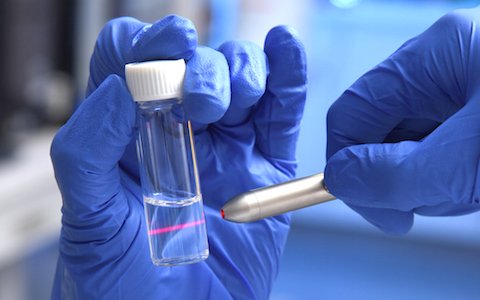The nanovaccine consists of tumor antigens — tumor proteins that can be recognized by the immune system — inside a synthetic polymer nanoparticle. Nanoparticle vaccines deliver minuscule particulates that stimulate the immune system to mount an immune response. The goal is to help people’s own bodies fight cancer.
«What is unique about our design is the simplicity of the
A study outlining this research, published online today in Nature Nanotechnology, reported that the nanovaccine had
The research was a collaboration between the laboratories of study senior authors Dr. Gao and Dr. Zhijian «James» Chen, Professor of Molecular Biology and Director of the Center for Inflammation Research. The Center was established in 2015 to study how the body senses infection and to develop approaches to exploit this knowledge to create new treatments for infection, immune disorders, and autoimmunity.

Laser light can be seen scattered by nanoparticles in a solution of the UTSW-developed nanovaccine.
Typical vaccines require immune cells to pick up tumor antigens in a «depot system» and then travel to the lymphoid organs for T cell activation, Dr. Gao said. Instead, nanoparticle vaccines can travel directly to the body’s lymph nodes to activate
«For nanoparticle vaccines to work, they must deliver antigens to proper cellular compartments within specialized immune cells called
In this case, the experimental UTSW nanovaccine works by activating an adaptor protein called STING, which in turn stimulates the body’s immune defense system to ward off cancer.
The scientists examined a variety of tumor models in mice: melanoma, colorectal cancer, and
Other vaccine technologies have been used in cancer immunotherapy. However, they are usually complex — consisting of live bacteria or multiplex biological stimulants, Dr. Gao said. This complexity can make production costly and, in some cases, lead to
With the emergence of new nanotechnology tools and increased understanding of polymeric drug delivery, Dr. Gao said, the field of nanoparticle vaccines has grown and attracted intense interest from academia and industry in the past decade.
«Recent advances in understanding innate and adaptive immunity have also led to more collaborations between immunologists and nanotechnologists," said Dr. Chen. «These partnerships are critical in propelling the rapid development of new generations of nanovaccines.»
The investigative team is now working with physicians at UT Southwestern to explore clinical testing of the
Study lead authors from UT Southwestern were Dr. Min Luo, research scientist; Dr. Hua Wang, Instructor of Molecular Biology; and Dr. Zhaohui Wang, postdoctoral fellow. Other UTSW researchers involved included graduate students Yang Li, Chensu Wang, Haocheng Cai, and Mingjian Du; Dr. Gang Huang, Instructor of Pharmacology and in the Simmons Comprehensive Cancer Center; Dr. Xiang Chen, research specialist; Dr. Zhigang Lu, Instructor of Physiology; Dr. Matthew Porembka, Assistant Professor of Surgery and a Dedman Family Scholar in Clinical Care; Dr. Jayanthi Lea, Associate Professor of Obstetrics and Gynecology and holder of the Patricia Duniven Fletcher Distinguished Professorship in Gynecological Oncology; Dr. Arthur Frankel, Professor of Internal Medicine and in the Simmons Comprehensive Cancer Center; and Dr.
Their work was supported by the National Institutes of Health, the Cancer Prevention and Research Institute of Texas, a UTSW Small Animal Imaging Resource grant and a Simmons Comprehensive Cancer Center support grant.
The Harold C. Simmons Comprehensive Cancer Center is the only
Source: http://www.utsouthwestern.edu/newsroom/news-releases/year-2017/apr/nano-cancer-therapy.html


